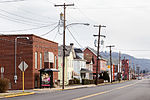Mingo Creek Viaduct
The Mingo Creek Viaduct, officially called the Joe Montana Bridges, are a pair of twin girder bridges that carry Pennsylvania Route 43 over the Mingo Creek, Pennsylvania Route 88, and the Wheeling and Lake Erie Railway between Union Township and Carroll Township, both of Washington County, Pennsylvania. The bridges were completed in April 2002 with spans of 2,400 feet (730 m) and heights of 250 feet (76 m), which makes them the highest bridges in the Pennsylvania Turnpike system. The Emlenton Bridge at 270 feet (82 m) is the only higher bridge in Pennsylvania.The bridges are named after Pro Football Hall of Fame NFL quarterback Joe Montana, who played for nearby Ringgold High School.
Excerpt from the Wikipedia article Mingo Creek Viaduct (License: CC BY-SA 3.0, Authors).Mingo Creek Viaduct
Mon/Fayette Expressway, Union Township
Geographical coordinates (GPS) Address Nearby Places Show on map
Geographical coordinates (GPS)
| Latitude | Longitude |
|---|---|
| N 40.2079 ° | E -79.9847 ° |
Address
Mon/Fayette Expressway
Mon/Fayette Expressway
15067 Union Township
Pennsylvania, United States
Open on Google Maps






